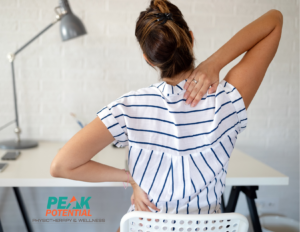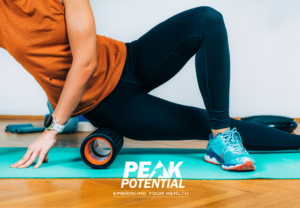It’s with excitement that we greet our clients at the
door. . . walking straighter, without a limp, no
longer grimacing, moving with pride and confidence.
Why does this thrill us so? Because the first time
we meet our clients this is what we often see. . .
They drag in from the door and lean over the
counter for support, unconsciously attempting to
alleviate discomfort. When they get up their chair
they are unable to stand erect. They have to take
a few steps before they straighten up.
We immediately know why you are here . . .
You want freedom from your pain and stiffness!
And we know that slumped over posture means
a tight and overlooked psoas muscle may be to
blame for your frustration.
My so-what muscle you may ask. . .
If you find yourself searching for relief from back,
groin, pelvic, or hip pain, you may need to
investigate your psoas muscles. Pronounced
“so-as”, these deep core muscles connect your
spine to your thigh bones.
What is the psoas muscle?
The psoas is hidden in your pelvis behind many
internal organs. Yout can’t see it when you flex in
the mirror, so it’s often forgotten when stretching
and strengthening. However, they are the
strongest of a group of muscles called the hip
flexors.
These muscles work to pull the thigh and trunk
toward each other. When tight or weak, you can
experience problems in the back, pelvis, or hip.
When healthy, it stabilizes the back, maintains
posture, and moves the legs.
Unfortunately, most of us have a tight psoas
muscle. This is due to spending much of our day
sitting. In this position, the distance between our
back and thighs becomes shorter. . . shortening the
connecting psoas muscle.
Why is the psoas muscle important?
A strong psoas muscle allows us to have a healthy
upright posture, back pain freedom, and optimal
sports performance. It’s used to flex your hip or
bring it forward when walking, marching, running,
or stair climbing.
Due to chronic poor postures, the psoas muscle
tightens, often with “knots” or trigger points in
the muscles. When too tight, it pulls the spine
and pelvis out of alignment.
The muscle is tired and tight causing pain and
weakness throughout the lower body that can make
even the easiest task a challenge. When in good
working order it gives you the support you need to
perform daily tasks. . . picking up groceries or
carrying a child.
What causes a tight psoas muscle?
- weak stomach or buttock muscles
- chronic sitting or slumping
- prolonged cycling or marching motions
- weak pelvic floor muscles or post pregnancy
- sleeping in a fetal position
- bad posture
What are the symptoms?
- limitations in hip movement
- pain across the front of the hip or groin
- low back pain
- deep pelvic pain
- chronic constipation or digestive issues
- difficulty taking a deep breath
- pain referred down the leg to the knee
- pain relieved when sitting
Chronic tightness can lead to additional problems
in the trunk and lower body including:
- forward tilted pelvis causing a “pot belly”
- hamstring strain
- knee pain or tendinitis
- nerve impingement in the hip
- sway back appearance
- increased risk for disc injury
Digestive and respiratory issue can also follow due
to the relationship of this muscle to both the
diaphragm and intestines.
How do you treat the psoas muscle?
Muscles and joints need to work together properly
for fluid pain free movement. Therefore,
comprehensive treatment must include the psoas
muscle AND all the surrounding muscles and joints.
A functional movement screen, as part of our
assessment, can show how all the parts are helping
or hindering one another. Treatment by a physical
therapist often includes stretching, soft tissue and
spine mobilization, and core strengthening. As
treatment progresses, posture becomes more
upright and pain symptoms decrease.
There are many things you can do at home to both
prevent and self treat tightness or weakness. Next
week we will explore more specifically what YOU
can do to care for your psoas.
If you are interested in finding out TODAY if your
psoas muscle is the cause of your back pain or hip
pain, request a free discovery call HERE.
Or learn more about natural back pain relief through
our free e-book link HERE.




